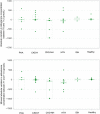Prospective evaluation of a telmisartan suppression test as a diagnostic tool for primary hyperaldosteronism in cats
- PMID: 37246725
- PMCID: PMC10365049
- DOI: 10.1111/jvim.16741
Prospective evaluation of a telmisartan suppression test as a diagnostic tool for primary hyperaldosteronism in cats
Abstract
Background: In a previous study, telmisartan suppressed aldosterone secretion in healthy cats but not in cats with primary hyperaldosteronism (PHA).
Hypotheses: Telmisartan suppresses aldosterone secretion in middle-aged healthy cat and cats with diseases that may result in secondary hyperaldosteronism, but not in those with PHA.
Animals: Thirty-eight cats: 5 with PHA; 16 with chronic kidney disease (CKD), subclassified as hypertensive (CKD-H) or non-hypertensive (CKD-NH); 9 with hyperthyroidism (HTH); 2 with idiopathic systemic arterial hypertension (ISH); and 6 healthy middle-aged cats.
Methods: Prospective, cross-sectional study. Serum aldosterone concentration, potassium concentration, and systolic blood pressure were measured before and 1 and 1.5 hours after PO administration of 2 mg/kg of telmisartan. The aldosterone variation rate (AVR) was calculated for each cat.
Results: No significant difference in the minimum AVR was observed among groups (median [quartile 1 (Q1); quartile 3 (Q3)]: 25 [0; 30]; 5 [-27; -75]; 10 [-6; -95]; 53 [19; 86]; 29 [5; 78]) for PHA, CKD, HTH, ISH, and healthy cats, respectively (P = .05). Basal serum aldosterone concentration (pmol/L) was significantly higher in PHA cats (median [Q1; Q3]: 2914 [2789; 4600]) than in CKD-H cats (median [Q1; Q3]: 239 [189; 577], corrected P value = .003) and CKD-NH cats (median [Q1; Q3]: 353 [136; 1371], corrected P value = .004).
Conclusions and clinical importance: The oral telmisartan suppression test using a single dose of 2 mg/kg telmisartan did not discriminate cats with PHA from healthy middle-aged cats or cats with diseases that may result in secondary hyperaldosteronism.
Keywords: adrenal; adrenal gland; aldosterone; cardiology; cardiovascular; endocrinology; hemodynamics; hypertension; hypertrophic cardiomyopathy; hypokalemia; retinopathy.
© 2023 The Authors. Journal of Veterinary Internal Medicine published by Wiley Periodicals LLC. on behalf of the American College of Veterinary Internal Medicine.
Conflict of interest statement
Residency program of Maxime Kurtz has received financial support by Royal Canin. No other authors have a conflict of interest.
Figures





References
-
- Kooistra HS. Primary hyperaldosteronism in cats: an underdiagnosed disorder. Vet Clin North Am Small Anim Pract. 2020;50(5):1053‐1063. - PubMed
-
- Javadi S, Slingerland LI, van de Beek MG, et al. Plasma renin activity and plasma concentrations of aldosterone, cortisol, adrenocorticotropic hormone, and alpha‐melanocyte‐stimulating hormone in healthy cats. J Vet Intern Med. 2004;18(5):625‐631. - PubMed
-
- Javadi S, Djajadiningrat‐Laanen SC, Kooistra HS, et al. Primary hyperaldosteronism, a mediator of progressive renal disease in cats. Domest Anim Endocrinol. 2005;28(1):85‐104. - PubMed
-
- Mulatero P, Monticone S, Deinum J, et al. Genetics, prevalence, screening and confirmation of primary aldosteronism: a position statement and consensus of the working group on endocrine hypertension of the European Society of Hypertension. J Hypertens. 2020;38(10):1919‐1928. - PubMed
MeSH terms
Substances
Supplementary concepts
Grants and funding
LinkOut - more resources
Full Text Sources
Medical
Miscellaneous

